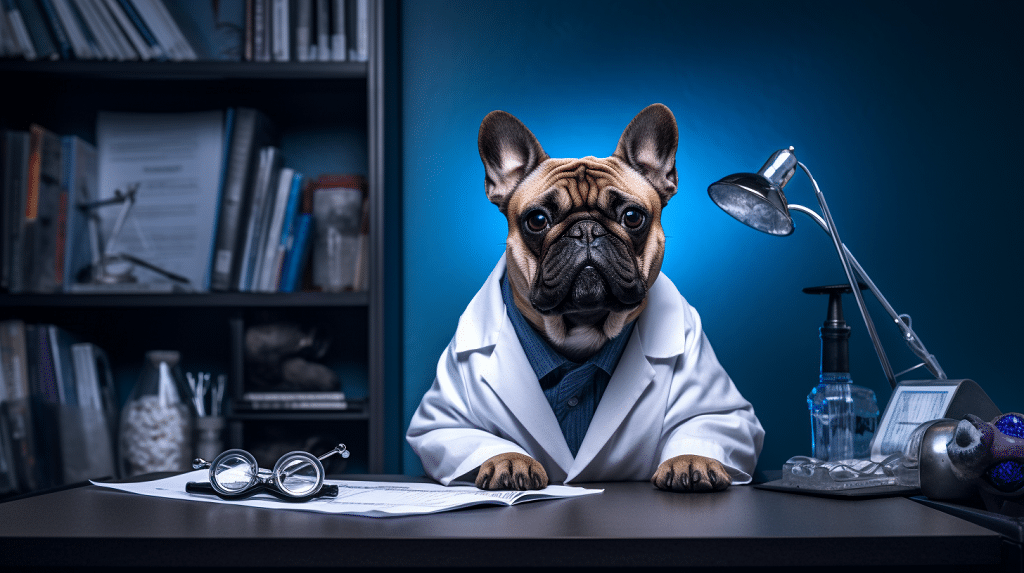French Bulldogs Have Health Problems: Don’t judge a book by its cover; your adorable French Bulldog’s cute squished face could hide potential health issues. You’re stepping into a world where brachycephalic syndrome, hip dysplasia, skin problems and eye conditions are common. But fear not; you’re not alone in this journey! So yes, French Bulldogs do have health problems. Let’s tackle these potential hurdles together, arming ourselves with knowledge and understanding to ensure your Frenchie stays as healthy as possible.
Understanding the Genetics of French Bulldogs
To understand whether French Bulldogs have health problems, you’ll first need to delve into their genetic makeup. Unravelling the genetic factors that contribute to their well-being is crucial in predicting potential health risks. Their adorable flat faces and compact bodies are due to selective breeding practices, which, unfortunately, may lead to a number of health issues.
Breeding practices over time have resulted in certain traits becoming prevalent within the breed. However, these practices can also inadvertently encourage the propagation of deleterious genes that cause diseases. For instance, breathing difficulties – known as brachycephalic syndrome – are common among French Bulldogs due to their physical features.
Effective health management starts with disease recognition. As a prospective owner, your guide should include understanding common conditions affecting this breed, such as hip dysplasia and various skin disorders. Equipped with this knowledge, you’ll be better prepared for the potential healthcare needs of your future pet.
Genetic testing is another important aspect of managing a French Bulldog’s health. These tests can help identify carriers of certain diseases before they’re passed onto future generations, ensuring healthier litters and reducing the overall prevalence of these conditions within the breed.
So yes, while it’s true that French Bulldogs can potentially face numerous health issues due to their genetics and breeding history, it doesn’t mean every Frenchie will suffer from them. With proper care and preemptive measures like genetic testing or screening for congenital disorders, you can significantly improve your pet’s quality of life.
In conclusion, understanding genetics helps predict possible challenges but doesn’t necessarily seal a dog’s fate. Your love and responsible ownership also play an instrumental role in shaping your Frenchie’s health.

Common Health Issues in French Bulldogs
You’re likely wondering what common health issues this breed tends to suffer from. French Bulldogs, like any other breed, have their own set of health challenges. However, with proper care and attention, these can be well managed or even prevented.
Below is a table summarizing the common issues:
| Health Issue | Description | Preventive Measures |
|---|---|---|
| Poor Nutrition | Regular grooming using hypoallergenic shampoos can help combat common skin issues in French Bulldogs. Monitor your dog’s skin condition closely and consult a vet if necessary. | French Bulldogs require a balanced diet to maintain optimal health. Overfeeding or underfeeding could lead to obesity or malnutrition, respectively. |
| Lack of Exercise | This breed requires regular but moderate exercise to stay healthy and prevent obesity. | Follow nutrition tips for French Bulldogs, such as providing high-quality dog food with the right mixture of proteins, fats and carbohydrates. |
| Dental Diseases | These dogs are prone to dental diseases due to their brachycephalic nature. | Regular dental care for French Bulldogs is essential. This includes brushing their teeth regularly and giving them safe chew toys. |
| Skin Conditions | Avoid exposing them to extreme temperatures or strenuous activities that may exacerbate breathing difficulties. | They are susceptible to skin issues like allergies, dermatitis, etc. |
| Breathing Difficulties | Due to their short snout, they often struggle with breathing problems. | Avoid exposing them to extreme temperatures or strenuous activities that may exacerbate breathing difficulties |
Remember that prevention is always better than cure when it comes to keeping your furry friend healthy! Stay vigilant about these potential risks by following preventive measures for French bulldogs’ health at all times.
How to Recognize Health Problems in Your French Bulldog
It’s crucial to know the signs of potential health problems in your furry friend, as early detection can make all the difference. As a French Bulldog owner, you’re part of an exclusive community that values both companionship and health maintenance.
One common sign of distress in French Bulldogs is sudden behavioural changes. If your usually lively pup becomes lethargic or shows decreased interest in play, it could be a symptom of underlying health issues. Increased thirst and urination are also warning signs not to ignore; these might indicate diabetes or kidney disease.
For prevention purposes, maintaining an optimal weight is paramount for this breed due to their predisposition for obesity-related ailments like orthopedic disorders. Regular exercise and a balanced diet are essential components of effective weight management.
Vet visits should ideally occur at least once annually, even if no symptoms are apparent. Routine check-ups help ensure early detection and intervention. Your vet may use diagnostic tools like blood tests or X-rays to screen for potential issues invisible to the naked eye.
Breathing difficulties typified by excessive panting or laboured breathing require immediate attention because French Bulldogs are brachycephalic (short-nosed) breeds prone to respiratory issues. Also, watch out for skin infections often evidenced by redness, itching, or unusual odour – another common problem associated with this breed’s unique skin folds.
Remember: Your proactive role contributes significantly towards ensuring your pup lives a long healthy life devoid of preventable diseases. Familiarize yourself with these signs and stay vigilant – it’s about belonging to a community that’s united not just by love for French Bulldogs but also their wellbeing.
The Role of Breeding in French Bulldogs’ Health
Breeding practices can significantly impact your pup’s overall well-being, so you’ll want to understand this aspect thoroughly. The impact of breeding practices on health cannot be overstated. For example, genetic diversity in French Bulldogs is crucial for their health and longevity. When breeders prioritize appearance over health, they may inadvertently perpetuate genetic disorders and other health issues.
As a prospective or current French Bulldog owner, it’s essential that you’re aware of the role of responsible breeders in improving health. They consciously strive to balance aesthetics with the physical wellness of their dogs by ensuring suitable pairing during breeding that promotes genetic diversity and limits the spread of hereditary diseases.
Breeding for health vs. appearance is a critical decision that ethical breeders make. Selecting parent dogs based on their robustness rather than just their looks helps maintain stronger, healthier bloodlines. This practice reduces the prevalence of certain conditions like brachycephalic syndrome linked to the breed’s distinct flat face or hip dysplasia related to its compact frame.
Last but not least comes the importance of health testing in breeding programs. By conducting regular screenings for known inherited diseases, responsible breeders can identify potential risks early and make informed decisions about mating pairs. These tests are pivotal tools in reducing disease incidence within breeds over time.

Managing Health Concerns in French Bulldogs
Managing your pup’s health concerns isn’t just about prevention, it’s equally important to know how to handle any potential issues that may arise. French Bulldogs, like all breeds, have their unique health needs and knowing how to manage these effectively can significantly improve their quality of life.
Here are some key areas you should be well-versed in:
- Managing allergies
- Dental care
- Exercise requirements
- Diet and nutrition
French Bulldogs are prone to allergies, which can manifest as skin problems or digestive issues. It’s crucial for you to recognize the signs of an allergic reaction and seek veterinary advice promptly.
Dental care is a critical aspect of your Frenchie’s overall health maintenance. Regular brushing and professional cleanings help prevent periodontal disease.
When it comes to exercise requirements, remember that French Bulldogs are brachycephalic (short-nosed) dogs with limited tolerance for strenuous physical activity. Therefore, they require moderate but regular exercise which improves cardiovascular health without causing undue respiratory distress.
Diet plays a significant role in managing your Frenchie’s weight, as obesity can exacerbate existing health conditions. Provide balanced nutrition while keeping portion sizes under control.
Don’t neglect grooming needs either; regular baths help remove allergens from the coat, reducing chances of skin infections.
You’re not alone on this journey! There’s a worldwide community of Frenchie owners who share your concerns and experiences. By educating yourself on these aspects of canine healthcare, you become part of an informed group committed to ensuring our furry friends live happy, healthy lives.
Prospective Owner’s Guide: What to Know About French Bulldogs’ Health
Before you bring a Frenchie into your home, it’s vital to understand the unique health issues they’re prone to. Their breed-specific characteristics may present certain challenges that require careful consideration and preparation. This includes their dietary needs, exercise requirements, grooming tips, common allergies, and preventive care measures.
French Bulldogs have specific dietary needs which need to be carefully monitored. They can suffer from food allergies, so it’s important to know what ingredients are in their meals.
Exercise is crucial for a Frenchie, but due to their brachycephalic nature (shortened head), overexertion can lead to breathing difficulties. Short walks or indoor play are usually enough for this breed.
Grooming is also key. Regular cleaning of their skin folds helps prevent infections, and checking their ears regularly for signs of infection is necessary as well.
Their flat faces make them susceptible to respiratory issues and overheating, while their compact bodies can lead to spinal disorders or joint diseases.
Here’s a quick reference table:
| Aspect | French Bulldog Needs | Notes |
|---|---|---|
| Dietary Needs | Specific diet | Avoid allergenic foods |
| Exercise | Moderate | Avoid overexertion |
| Grooming | Regular | Clean skin folds |
Understanding these factors will help you ensure your Frenchie stays healthy and happy throughout its life. Remember, prevention is better than cure, so regular vet check-ups should be part of your preventive care measures.
Frequently Asked Questions
Do French Bulldogs Have a Shorter Lifespan Due to Their Health Problems?
Yes, French Bulldogs often have a shorter lifespan due to health problems. Their genetic predispositions and certain breeding practices can lead to various health issues. When compared to other breeds, their lifespan is generally shorter. However, with proper veterinary interventions, you can manage these health problems effectively. It’s important to note that mortality rates vary, and every dog is unique. So, while they may face challenges, your love and care can make a big difference in their lives.
Can a French Bulldog’s Diet Influence Their Susceptibility to Health Problems?
Yes, your French Bulldog’s diet can influence their susceptibility to health problems. Feeding them the wrong foods can lead to food allergies, obesity risks, and digestive issues. It’s crucial you’re aware of their nutritional needs and adjust their diet accordingly. Diet variations could help manage these issues better. Remember, every dog is unique; what works for one might not work for another. Consult a vet about the best dietary approach for your Frenchie to ensure they remain healthy.
Are There Any Specific Activities or Exercises That Should Be Avoided to Prevent Health Issues in French Bulldogs?
Yes, there are specific activities you should steer your French Bulldog clear of to maintain their health. Avoid bulldog swimming and high-intensity exercise, as they can cause undue stress. Stair climbing, too, might lead to joint issues. Focus on weight management through moderate activity and a balanced diet. Always keep an eye out for signs of overheating, providing plenty of shade and water during playtime. Remember, it’s about creating a safe, enjoyable environment for your cherished pet!
How Does the Environment and Climate Affect the Health of French Bulldogs?
Sure, climate and environment significantly impact your French Bulldog’s health. Climate adaptation is crucial as they’re sensitive to temperature extremes. Cold conditions can cause hypothermia, while hot humid weather often leads to overheating. Housing conditions should be comfortable and allergen-free, as allergenic triggers may induce respiratory distress. Always maintain a moderate room temperature and humidity level for optimal health.
Are There Any Preventative Measures or Vaccinations for the Common Health Issues in French Bulldogs?
Yes, there are several measures you can take to prevent common health issues in your French Bulldog. Regular check-ups and dental care are crucial. You should also look into genetic testing for hereditary diseases and be selective with breeding practices. It’s worth considering health insurance to cover potential vet costs. Remember, a healthy dog is a happy one!
Conclusion
In conclusion, owning a French Bulldog can be both rewarding and challenging. Their adorable features may come with health implications like brachycephalic syndrome or hip dysplasia. But remember, knowledge is power! Being aware of these potential issues and selecting puppies from reputable breeders can help ensure your Frenchie lives a healthy life. So, step into this journey with open eyes and an informed mind – for the love of our four-legged friends!


